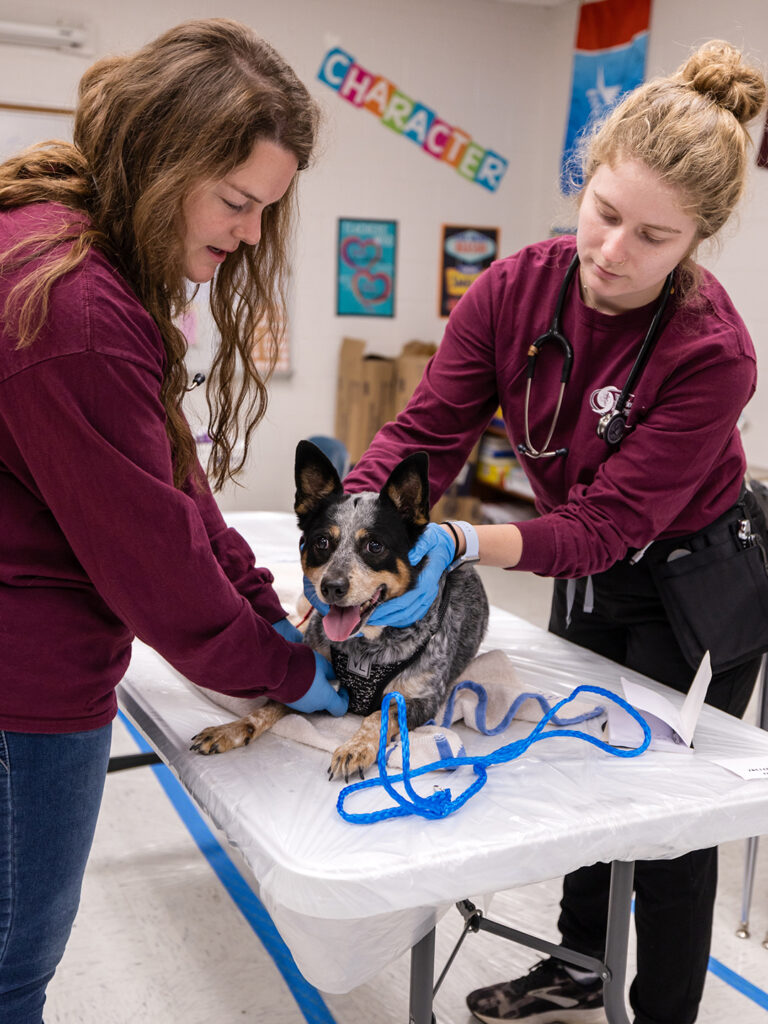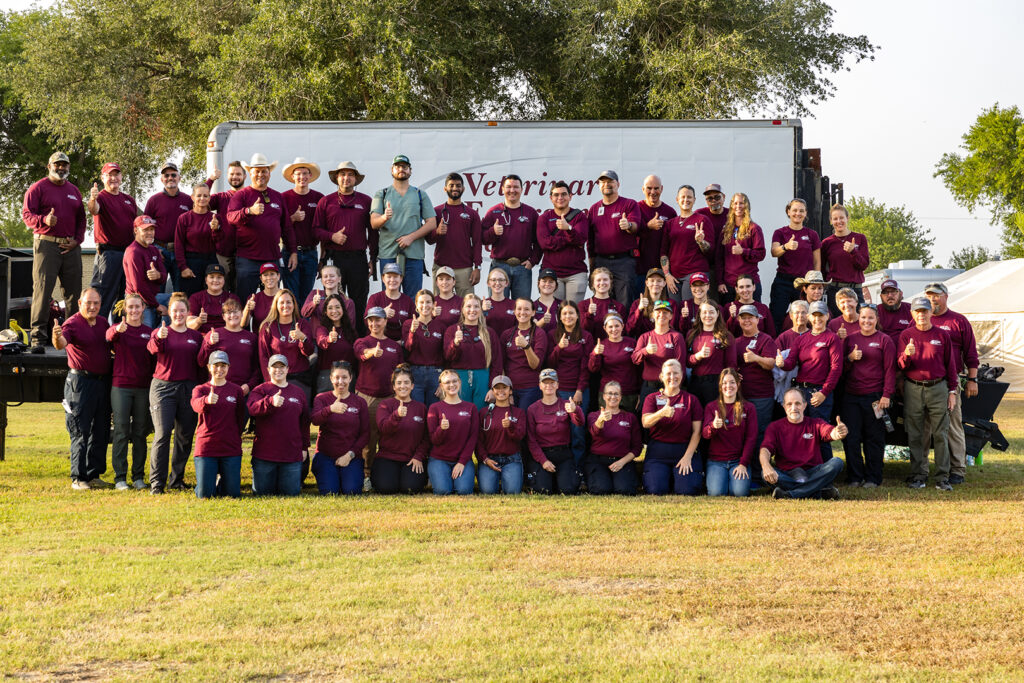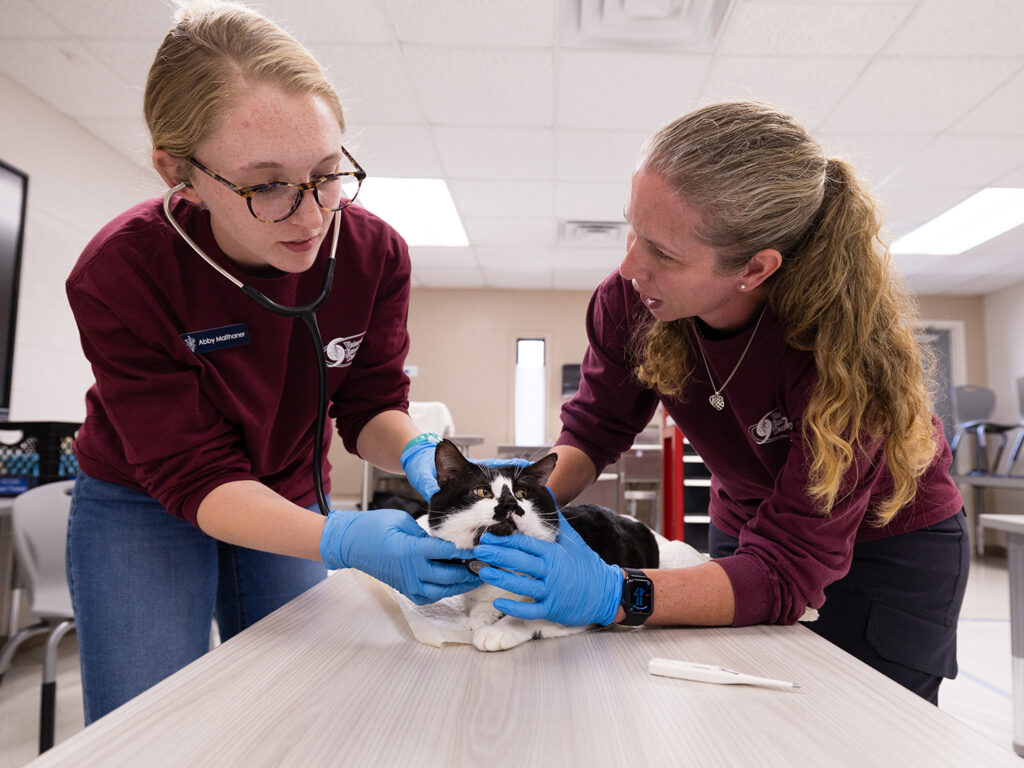Texas A&M Veterinary Emergency Team Sees Record Number Of Patients At Operation Border Health Preparedness
Story by Rachel Knight, VMBS Communications

In the early hours of July 22, long before the sun began its ascent over the Brazos Valley, cars began turning into The Texas A&M University System RELLIS campus.
Early risers gathered to join the Texas A&M Veterinary Emergency Team (VET) on its journey to South Texas for Operation Border Health Preparedness (OBHP), an annual readiness exercise hosted by the Texas Department of State Health Services that provides emergency response teams the opportunity to test their readiness for the next major disaster while also providing annual medical and veterinary care to communities that would otherwise go without it.
The team worked throughout the weekend to establish a base of operations at Raymondville Early College High School with the Texas A&M AgriLife Extension Service Disaster Assessment and Recovery (DAR) team, which provides logistical and administrative support to the VET during deployments.
The group’s efforts in setting up tents, pet-proofing classrooms and practicing with the team’s medical records system were met Monday morning with enthusiastic Texans eager to receive veterinary care for their beloved cats and dogs.
By the end of day one, the VET had served 119 patients. By the end of the week, the team had completed a record 1,022 veterinary visits at its base of operations in Willacy County, which almost doubled the number of patients the team saw in 2022 and is significantly higher than their caseload in 2021, the team’s first year to participate.
“Willacy County is historically the poorest in Texas and the fifth poorest in the nation, with no veterinarian serving the community,” said Dr. Wesley Bissett, VET director. “But the people here love their animals as much as any other Texan, and their animals deserve care. We’re honored to have the opportunity to provide that care at OBHP at no cost thanks, in part, to the generosity of organizations like the Banfield Foundation.”
Sixteen School of Veterinary Medicine & Biomedical Sciences Doctor of Veterinary Medicine students joined the VET at OBHP in 2023, giving them hands-on experience in providing veterinary medicine in a disaster exercise. Daniel Martinez, a fourth-year veterinary student originally from the Rio Grande Valley, was among the students who participated in OBHP.
“The Rio Grande Valley is a poverty-stricken area of Texas where citizens live in multi-person households, with median household incomes that look like the price tag of a modest used car, about $40,000 in Willacy County,” Martinez said. “Regardless, clients were bringing in their pets to us, sacrificing their resources to make the trip to Raymondville Early College High School where the VET and DAR provided a service deemed essential to the community.”
Dr. Deb Zoran, a professor of small animal medicine and founding member of the VET, teaches the two-week VET rotation course to fourth-year students when she’s not deployed with the VET or providing medical care as the veterinarian to the Texas A&M Task Force 1 urban search and rescue dogs.

“The VET rotation is built like every other two-week rotation in the school,” Zoran said. “We split the rotation into one week of preparedness and one week of response. As it turns out, OBHP happens to fall on a response week, so students on the VET rotation during OBHP don’t just practice in a virtually simulated deployment; they get to participate in a full-scale disaster response exercise with hands-on participation in establishing a base of operations and providing basic veterinary care.”
The experience is invaluable.
Martinez said he saw the best of humanity in his mentors, fellow students and clients at OBHP.
“I built relationships with my classmates, teachers and other personnel that demonstrate the core values of Texas A&M University,” Martinez said. “The VET and DAR working together was a workshop in teamwork. The veterinary profession cannot exist without teamwork. What happened in Raymondville is just a snapshot of what can happen when caring individuals come together.
“This year’s Operation Border Health Preparedness added value to my professional veterinary medical education by underscoring the synergy of the veterinary profession and the demographic it serves,” he said.
One of the families that brought its pets to OBHP for basic veterinary care echoed Martinez’s admiration for the services provided by the VET and DAR. The Gonzalez family adopted two calico kittens at the beginning of the COVID-19 pandemic, naming them Snickers and KitKat.
“The initial thought was that they’d be animals who helped keep our kids sane during the early challenges of COVID, but they quickly became much more than that — they’re two additional members of the family,” said Roel Gonzalez, a math teacher at Raymondville Early College High School. “They really care about my kids, and my kids have so much affection for them. It’s nice to be able to bring them here for veterinary care so that we can take care of them the way they’ve been caring for us over the last few years.”

The VET is able to focus on caring for family members like Snickers and KitKat on deployments rather than having to expend the team’s energy on some of the more logistical elements of a deployment, thanks to help from the DAR team.
“We deploy in cooperation with the VET to help with logistical support,” said Rachel Bauer, the liaison to Texas A&M AgriLife Extension at the state operations center in Austin who also works with the Texas Division of Emergency Management. “Our AgriLife Extension Disaster Assessment and Recovery agents free up the VET members to focus on providing the best veterinary care possible. We do this by working to keep the generators running, greeting the public and guiding them on where to go once they’ve entered the VET’s base of operations, and providing any other logistical support they may need.”
Dr. Monty Dozier, the program director for the DAR team, said OBHP is a meaningful experience because it builds connections with people and organizations across the state while furthering the connection between DAR and the VET.
“Our partnership with the Texas A&M VET is one that we value highly, and OBHP is an opportunity for us to work together to make things better for Texas,” he said. “We get to practice our techniques for training and working with volunteers, which is important because during a disaster response, we take in volunteers and train them on how to contribute to our efforts.”
Bissett and Zoran said the DAR agents who deploy with the team make their operations smoother while adding an element of comradery.
They also pointed out that the VET would not be able to provide the care and services it offers at OBHP without generous donors. Bissett estimated that the care the team provided at no-cost to South Texans during OBHP would have equated to $400,000 in out-of-pocket expenses at a traditional veterinary clinic.
“OBHP is not possible without the support we receive from our donors; they make it possible to provide veterinary care to this special community,” Zoran said. “We are beyond thankful to our donors for seeing the importance of making veterinary care more accessible and the value in investing in the VET to make that possible at OBHP.”
###
For more information about the Texas A&M School of Veterinary Medicine & Biomedical Sciences, please visit our website at vetmed.tamu.edu or join us on Facebook, Instagram, and Twitter.
Contact Information: Jennifer Gauntt, Director of VMBS Communications, Texas A&M School of Veterinary Medicine & Biomedical Sciences, jgauntt@cvm.tamu.edu, 979-862-4216


